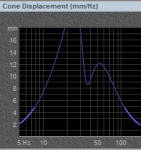Re: Simple sub design
I think you will find that underlapping crossover points for the sub and mains bandpasses, especially with the usual 6-12dB increase in sub gain over the mains, will result is far too many consequences in today's predominantly aux-fed-sub PAs. It also makes timing kind of a pain in the ass. If you think about it, to underlap the crossovers you have to set your sub LPF at something like 50Hz, and your mains HPF at something like 120Hz. Sure, they sum nicely when playing together, but now every source you don't put in the subs sounds super thin. You're also going to have frequency domain interaction between the sub protective HPF and system integration LPF, resulting in reduced level and increased drive requirements... not helpful on a subsystem that is already restricted to maybe 1.5 octaves of bandwidth.
Personally I prefer to significantly overlap the sub and mains crossovers, so the mains are running down to maybe 40 or 50Hz and the subs get knocked out an octave higher. Timing is much easier, transients are preserved, and a little EQ boost to the very lowest end of the sub response makes the summed systems have a nice rising slope into the LF.
It's no coincidence that this big bump is at a typical (electrical) crossover frequency between subs and tops. If you're going to push the level on the subs for a rising system response al low frequencies, you probably should be thinking about underlapping the low and sub passbands to reduce buildup at the crossover.
I think you will find that underlapping crossover points for the sub and mains bandpasses, especially with the usual 6-12dB increase in sub gain over the mains, will result is far too many consequences in today's predominantly aux-fed-sub PAs. It also makes timing kind of a pain in the ass. If you think about it, to underlap the crossovers you have to set your sub LPF at something like 50Hz, and your mains HPF at something like 120Hz. Sure, they sum nicely when playing together, but now every source you don't put in the subs sounds super thin. You're also going to have frequency domain interaction between the sub protective HPF and system integration LPF, resulting in reduced level and increased drive requirements... not helpful on a subsystem that is already restricted to maybe 1.5 octaves of bandwidth.
Personally I prefer to significantly overlap the sub and mains crossovers, so the mains are running down to maybe 40 or 50Hz and the subs get knocked out an octave higher. Timing is much easier, transients are preserved, and a little EQ boost to the very lowest end of the sub response makes the summed systems have a nice rising slope into the LF.








